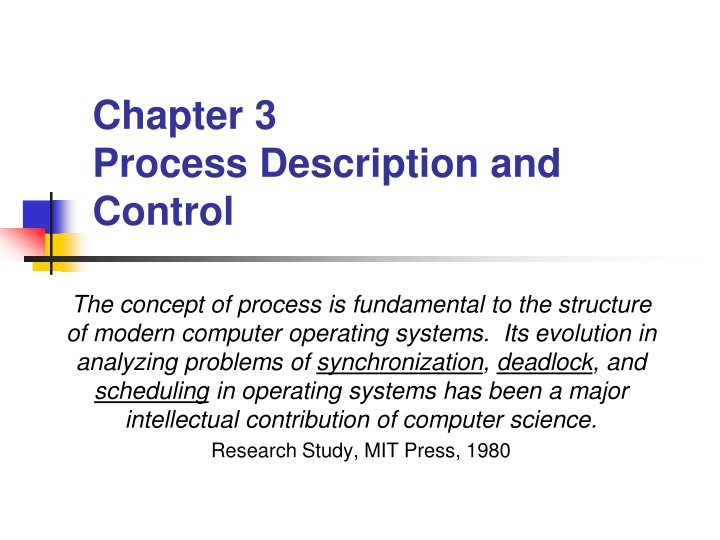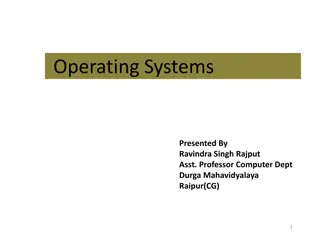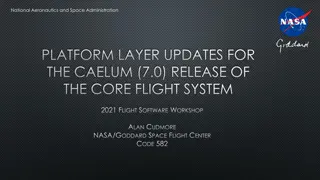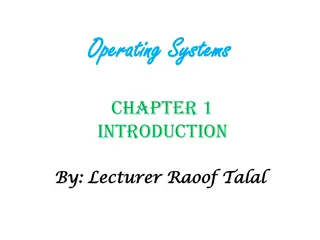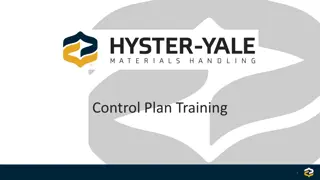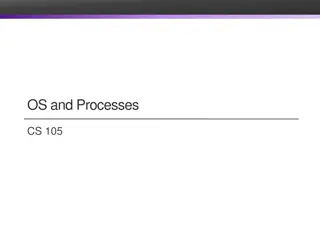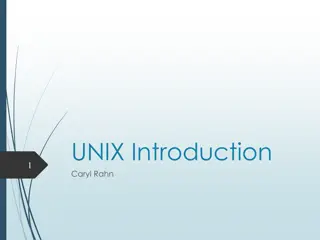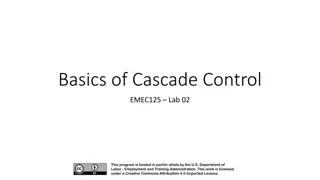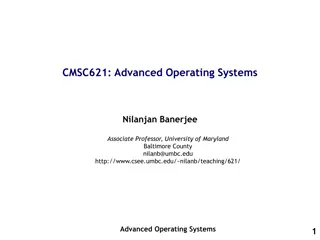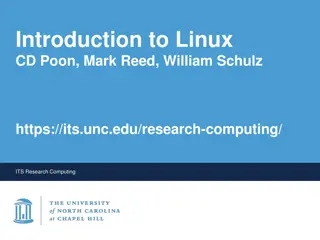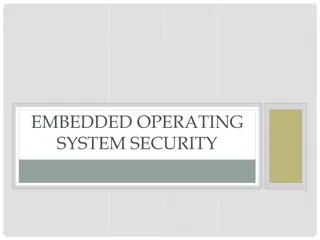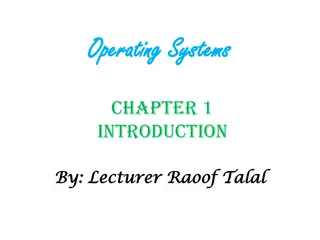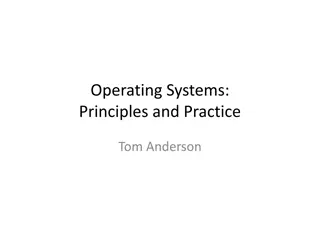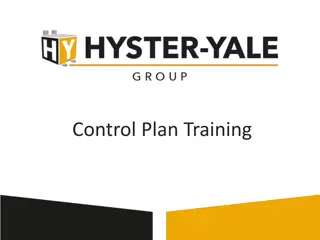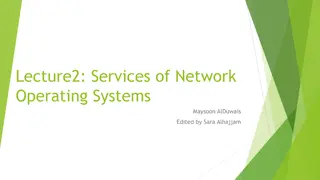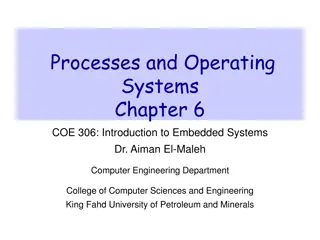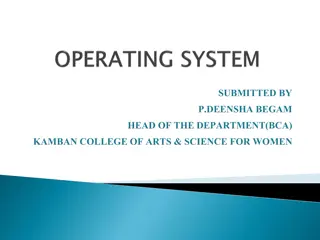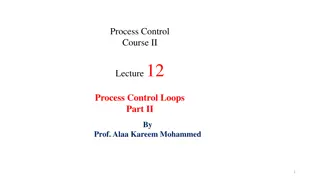Process Description and Control in Operating Systems
The concept of process is fundamental in modern computer operating systems, addressing issues like synchronization, deadlock, and scheduling. This chapter delves into process management, state transitions, data structures, execution, security, and UNIX SVR4 scheme. Learn about process control blocks, state modeling, key security concerns, and process management in UNIX SVR4.
Download Presentation

Please find below an Image/Link to download the presentation.
The content on the website is provided AS IS for your information and personal use only. It may not be sold, licensed, or shared on other websites without obtaining consent from the author.If you encounter any issues during the download, it is possible that the publisher has removed the file from their server.
You are allowed to download the files provided on this website for personal or commercial use, subject to the condition that they are used lawfully. All files are the property of their respective owners.
The content on the website is provided AS IS for your information and personal use only. It may not be sold, licensed, or shared on other websites without obtaining consent from the author.
E N D
Presentation Transcript
Chapter 3 Process Description and Control The concept of process is fundamental to the structure of modern computer operating systems. Its evolution in analyzing problems of synchronization, deadlock, and scheduling in operating systems has been a major intellectual contribution of computer science. Research Study, MIT Press, 1980
CS 345 # 4 Project P1: Shell Stalling s Chapter 1: Computer System Overview 2: Operating System Overview 3: Process Description and Control 4: Threads 5: Concurrency: ME and Synchronization 6: Concurrency: Deadlock and Starvation 7: Memory Management 8: Virtual memory 9: Uniprocessor Scheduling 10: Multiprocessor and Real-Time Scheduling 11: I/O Management and Disk Scheduling 12: File Management Student Presentations 4 P2: Tasking 6 P3: Jurassic Park 6 P4: Virtual Memory 6 P5: Scheduling 8 P6: FAT 6 BYU CS 345 Chapter 3 - Processes 2
Chapter 3 Learning Objectives Define the term process and explain the relationship between processes and process control blocks. Explain the concept of a process state and discuss the state transitions the processes undergo. List and describe the purpose of the data structures and data structure elements used by an OS to manage processes. Assess the requirements for process control by the OS. Understand the issues involved in the execution of OS code. Assess the key security issues that relate to operation systems. Describe the process management scheme for UNIX SVR4. BYU CS 345 Chapter 3 - Processes 3
Large Building Project Identify Computer Data Context Programs Interrupts Builder (General Contractor) Operating System Materials Scheduling 2 State 5 state Workers Resources States New Working Waiting Blocked Suspended Completed Building Process Tools Threads What needs to be Managed? Libraries BYU CS 345 Chapter 3 - Processes 4
Questions 1. What is a process? 2. When is a process created? 3. When is a process terminated? 4. What is a 2-state scheduling model? 5. What additional states are added with a 5-state model? 6. How does a suspended process differ from a blocked process? 7. What task variables are found in a Task Control Table? BYU CS 345 Chapter 3 - Processes 5
Process 1. What is a Process (or Task)? Sequence of instructions that executes The entity that can be assigned to and executed on a processor A unit of activity characterized by a single sequential thread of execution Can be traced Associated data needed by the program Context All information the operating system needs to manage the process A current state and an associated set of system resources BYU CS 345 Chapter 3 - Processes 6
Process OS Process Support? Assist the execution of a process interleave the execution of several processes maximize processor utilization provide reasonable response time Allocate resources to processes fairness avoid starvation / deadlock Support interprocess activities communication user creation of processes BYU CS 345 Chapter 3 - Processes 7
Process Process Implementation Process Control Blocks Active Context Process BYU CS 345 Chapter 3 - Processes 8
Process Process Trace An instruction trace reveals the overhead required to multi-process. BYU CS 345 Chapter 3 - Processes 9
Process Creation 2. When is a Process Created? Submission of a batch job User logs on Created to provide a service such as printing Process creates another process Modularity Parallelism Parent child relationship Deciding how to allocate the resources is a policy that is determined by the OS BYU CS 345 Chapter 3 - Processes 10
Process Creation Process Creation Decisions Resource Allocation Treat as a new process Divide parent s resources among children Execution child runs concurrently with parent parent waits until some or all children terminate Address Space copy of parent new program loaded into address space BYU CS 345 Chapter 3 - Processes 11
Process Creation Example: Unix Process Creation A new process is created by the fork call Child and parent are identical child returns a 0 parent returns nonzero Both parent and child execute next line Often the child executes an exec creates a brand new process in its space Parent can execute a wait BYU CS 345 Chapter 3 - Processes 12
Process Creation Unix Example fork() returns: -1 = error 0 = child >0 = parent switch (child1 = fork()) { case 1: printf("Can't fork"); exit(-1); case 0: child1P(one2two, two2one); exit(-2); default: switch (child2 = fork()) { case 1: printf("Can't fork"); case 0: default: // Wait for child two } /* Wait for child one */ waitpid(child1, status1, options); fflush(stdout); } // child 1 // parent exit(-1); child2P(one2two, two2one); exit(-3); waitpid() joins parent & child waitpid(child2, status2, options); BYU CS 345 Chapter 3 - Processes 13
Process Creation Windows NT process creation Windows subsystem has no understanding of parent / child relationship. Process created by CreateProcess system call Similar to fork-execve model No process group concept Child executes concurrently with parent Loads a program into the address space of the child process Processes are objects and have handles Parent uses WaitForSingleObject() function to wait for child process termination. BYU CS 345 Chapter 3 - Processes 14
Process Creation Windows NT Example // Now create the child process. PROCESS_INFORMATION piProcInfo; STARTUPINFO siStartInfo; // Set up members of STARTUPINFO structure. ZeroMemory( &siStartInfo, sizeof(STARTUPINFO) ); siStartInfo.cb = sizeof(STARTUPINFO); // Create the child process. CreateProcess(NULL, program, // command line NULL, // process security attributes NULL, // primary thread security attributes TRUE, // handles are inherited 0, // creation flags NULL, // use parent's environment NULL, // use parent's current directory &siStartInfo, // STARTUPINFO pointer &piProcInfo); // receives PROCESS_INFORMATION BYU CS 345 Chapter 3 - Processes 15
Process Termination 3. When is a Process Terminated? User logs off Normal completion Batch issues Halt Time limit exceeded Memory unavailable Bounds violation Protection error example write to read-only file Arithmetic error Time overrun event timeout I/O failure Invalid instruction tried to execute data Privileged instruction Data misuse Operating system intervention such as when deadlock occurs Parent terminates so child processes terminate Parent request BYU CS 345 Chapter 3 - Processes 16
2-State Model 4. What is a 2-State Scheduling Model? Process may be in one of two states Running Not-running BYU CS 345 Chapter 3 - Processes 17
2-State Model Two-state Model Problems What does not-running mean? Ready to execute? Blocked? Suspended? Terminated? Priority? Scheduler/dispatcher cannot just select the process that has been in the queue the longest. Challenge to make overall system as efficient and fair as possible. BYU CS 345 Chapter 3 - Processes 18
5-State Model 5. What is a 5-State Scheduling Model? BYU CS 345 Chapter 3 - Processes 19
5-State Model Five-state Model Transitions Null New handle another process (Admit) Ready Running: Select another process to run (Dispatch) Running Exit: Process has terminated (Release) Running Ready: End of time slice or higher-priority process is ready (Timeout) Running Blocked: Process waiting for event (Event Wait) Blocked Ready: The event a process is waiting for has occurred, can continue (Event Occurs) Ready Exit: Process terminated by O.S. or parent Blocked Exit: Same reasons New: Process is created Ready: O.S. is ready to BYU CS 345 Chapter 3 - Processes 20
5-State Model Multiple Blocked Queues BYU CS 345 Chapter 3 - Processes 21
P2 - Tasking 5-State Scheduler #define SWAP swapTask(); #define SEM_WAIT(s) semWait(s); #define SEM_SIGNAL(s) semSignal(s); #define SEM_TRYLOCK(s) semTryLock(s); dispatch() createTask() killTask() Ready Queue New Running Exit swapTask() Blocked Queues Project 2 - Tasking BYU CS 345 Chapter 3 - Processes 22
Suspended Process 6. What is a Suspended Process? Processor is faster than I/O so all processes could be waiting for I/O Swap these processes to disk to free up more memory Blocked state becomes suspended state when swapped to disk Two new states Blocked, suspend Ready, suspend BYU CS 345 Chapter 3 - Processes 23
Suspended Process Suspended State Scheduling One Suspend State Two Suspend State BYU CS 345 Chapter 3 - Processes 24
Suspended Process Reasons for Process Suspension Swapping The OS needs to release sufficient main memory to bring in a process that is ready to execute Other OS reason The OS may suspend a background or utility process or a process that is suspected of causing a problem Interactive user request A user may wish to suspend execution of a program for purposes of debugging or in connection with the use of a resource Timing A process may be executed periodically and may be suspended while waiting for the next time interval Parent process request A parent process may wish to suspend execution of a descendent to examine or modify the suspended process BYU CS 345 Chapter 3 - Processes 25
Chapter 3 Learning Objectives Define the term process and explain the relationship between processes and process control blocks. Explain the concept of a process state and discuss the state transitions the processes undergo. List and describe the purpose of the data structures and data structure elements used by an OS to manage processes. Assess the requirements for process control by the OS. Understand the issues involved in the execution of OS code. Assess the key security issues that relate to operation systems. Describe the process management scheme for UNIX SVR4. BYU CS 345 Chapter 3 - Processes 26
Control Tables 7. Operating System Control Tables OS Tables Task Control Blocks BYU CS 345 Chapter 3 - Processes 27
Control Tables Control Tables Memory Tables Allocation of main memory to processes Allocation of secondary memory to processes Protection attributes for access to shared memory regions Information needed to manage virtual memory I/O device is available or assigned Status of I/O operation Location in main memory being used as the source or destination of the I/O transfer BYU CS 345 Chapter 3 - Processes 28
Control Tables Control Tables File Tables Existence of files Location on secondary memory Current Status Attributes Usually maintained by a file management system Process Table Process ID Process state Location in memory BYU CS 345 Chapter 3 - Processes 29
Control Tables Process Location Process includes set of programs to be executed Data locations for local and global variables Any defined constants Stack Process Control Block (PCB) Collection of attributes Process image Collection of program, data, stack, and attributes BYU CS 345 Chapter 3 - Processes 30
P2 - Tasking Task Control Block (tcb) // task control block typedef struct { char* name; int (*task)(int,char**); int state; int priority; int argc; char** argv; // task control block // task name // task address // task state // task priority (P2) // task argument count (P1) // task argument pointers (P1) int signal; void (*sigContHandler)(void); void (*sigIntHandler)(void); void (*sigTermHandler)(void); void (*sigTstpHandler)(void); // task signals (P1) // task mySIGCONT handler (P1) // task mySIGINT handler (P1) // task mySIGTERM handler (P1) // task mySIGTSTP handler (P1) } TCB; TID parent; int RPT; int cdir; Semaphore *event; void* stack; jmp_buf context; // task parent // task root page table (P4) // task directory (P6) // blocked task semaphore (P2) // task stack (P2) // task context pointer (P2) BYU CS 345 Chapter 3 - Processes 31
P2 - Tasking Step 1: Priority Queue Create a priority queue: typedef uint8_t TID; typedef int16_t PQEntry; typedef PQEntry* PQueue; PQueue rq; rq = (PQEntry*)malloc(MAX_TASKS * sizeof(PQEntry)); rq[0] = 0; Suggested priority queue functions: TID enQ(PQueue q, PQEntry pqe); q priority queue (# | pr1/tid1 | pr2/tid2 | ) pqe (task priority << 8) + task id TID returned task id PQEntry deQ(PQueue q, TID tid); q priority queue tid if (0xff) then {deQ q[q[0]]} else {deQ tid} PQEntry returned deQ d entry if (-1) then {tid not found or empty q} Priority/TID Priority/TID Priority/TID Priority/TID # of entries // task ID (0-255) // task priority/ID // priority queue // ready queue // init ready queue rq[5] rq[4] rq[3] rq[2] rq[1] rq[0] 10 / 3 5 / 2 5 / 0 2 / 1 4 BYU CS 345 Chapter 3 - Processes 32
BYU CS 345 Chapter 3 - Processes 33
